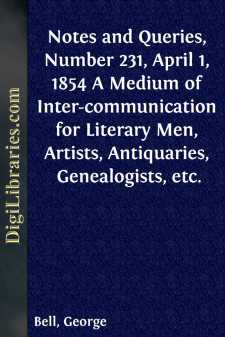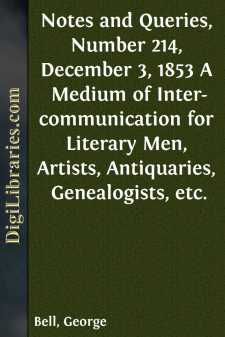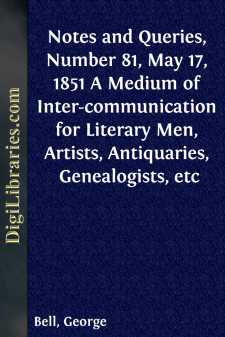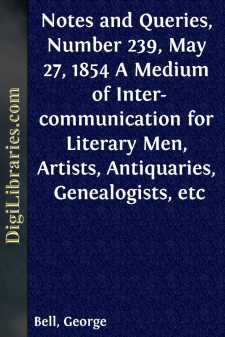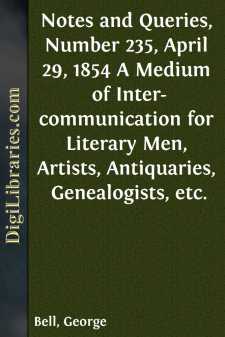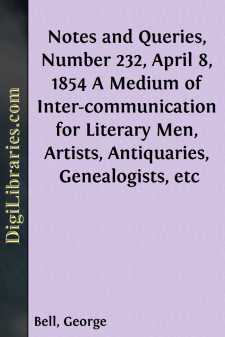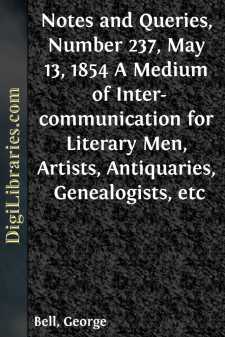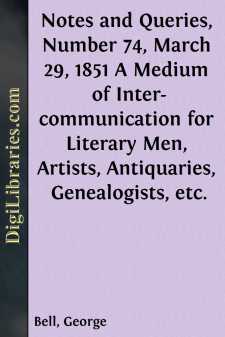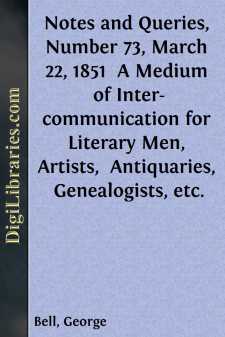Categories
- Antiques & Collectibles 13
- Architecture 36
- Art 48
- Bibles 22
- Biography & Autobiography 813
- Body, Mind & Spirit 142
- Business & Economics 28
- Children's Books 15
- Children's Fiction 12
- Computers 4
- Cooking 94
- Crafts & Hobbies 4
- Drama 346
- Education 46
- Family & Relationships 57
- Fiction 11828
- Games 19
- Gardening 17
- Health & Fitness 34
- History 1377
- House & Home 1
- Humor 147
- Juvenile Fiction 1873
- Juvenile Nonfiction 202
- Language Arts & Disciplines 88
- Law 16
- Literary Collections 686
- Literary Criticism 179
- Mathematics 13
- Medical 41
- Music 40
- Nature 179
- Non-Classifiable 1768
- Performing Arts 7
- Periodicals 1453
- Philosophy 64
- Photography 2
- Poetry 896
- Political Science 203
- Psychology 42
- Reference 154
- Religion 513
- Science 126
- Self-Help 84
- Social Science 81
- Sports & Recreation 34
- Study Aids 3
- Technology & Engineering 59
- Transportation 23
- Travel 463
- True Crime 29
Notes and Queries, Number 231, April 1, 1854 A Medium of Inter-communication for Literary Men, Artists, Antiquaries, Genealogists, etc.
by: George Bell
Categories:
Description:
Excerpt
KENNINGTON COMMON.
Before all traces be lost of Kennington Common, so soon to be distinguished by the euphonious epithet of Park, let me put a Query to some of your antiquarian readers in relation thereunto; and suffer me to make the Query a peg, whereon to hang sundry and divers little notes. And pray let no one ridicule the idea that Kennington has its antiquities; albeit that wherever you look, new buildings, new bricks and mortar, plaster and cement, will meet your eye; yet, does not the manor figure in Domesday Book? Is it not dignified by the stately name of Chenintune? Was it not held by Theodoric of King Edward the Confessor? And did it not, in times gone by, possess a royal residence?
Here, at a Danish marriage, died Hardi Knute in 1041. Here, Harold, son of Earl Godwin, who seized the crown after the death of the Confessor, is said to have placed it on his own head. Here, in 1231, King Henry III. held his court, and passed a solemn and a stately Christmas. And here, says Matthew Paris, was held a Parliament in the succeeding year. Hither, says good old Stow, anno 1376, came the Duke of Lancaster to escape the fury of the populace of London, on Friday, February 20, the day following that on which Wicliffe had been brought before the bishops at St. Paul's. The Duke was dining "with one John of Ipres" when the news arrived, borne by a breathless messenger, that the people sought his life. When the Duke "leapt so hastily from his oysters, that he hurt both his legges against the foarme: wine was offered to his oysters, but hee would not drinke for haste; he fledde with his fellowe Syr Henry Percy, no man following them; and entring the Thamis, neuer stinted rowing vntill they came to a house neere the manor of Kenington (besides Lambeth), where at that time the Princesse was, with the young Prince, before whom hee made his complaint." Doubtless, Lambeth Marsh was then what its name imports. Hither also came a deputation of the chiefest citizens to Richard II., June 21, 1377, "before the old King was departed," "to accept him for their true and lawfull King and Gouernor." But the royal residence was destroyed before 1607. "The last of the long succession of royal tenants who inhabited the ancient site," says a writer in the Illustrated London News not long since (I have the cutting, but neglected to note the date of the paper), "was Charles I., when Prince of Wales: his lodging, a house built upon a part of the site of the old palace, is the only existing vestige, as represented in the accompanying engraving (in the Illus. Lond. News), unless earlier remains are to be found in the lower parts of the interior." But I believe that the identity of the site of this ancient mansion (which is situated on the western side of Lower Kennington Lane), with part of the site of the old palace, is not quite so certain as the writer appears to intimate. In 1720, however, the manor gave the title of Earl to William Augustus, Duke of Cumberland, second son to George II.
Kennington Common acquired an unenviable notoriety from being the place of execution for malefactors tried in this part of the county....


